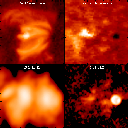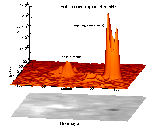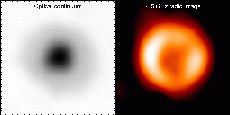


The top left panel of the leftmost image (click it to see a larger view) shows a view of the region in soft X-rays, taken with an X-ray telescope on the Earth-orbiting Japanese satellite Yohkoh. In X-rays we see regions of hot dense gas above the surface (at temperatures of millions of degrees), which here can be seen to be following magnetic field lines connecting a sunspot at the front of the actrive region to weaker fields at the back. The top right panel is an optical image of the region's surface (false color): the sunspot shows up as a dark circle because it is cooler than the rest of the Sun's surface. The two bottom panels show the region at two radio wavelengths: 1.5 GHz on the left, where we again see mostly the densest gas in the corona above the surface; and 5 GHz on the right, where the magnetic field of the sunspot makes it a much brighter source than the hot gas to the left.
The middle image shows the 5 GHz radio mage in another representation to emphasize the relative brightness of the sunspot and the hot dense gas, also called plage, at the "back" of the active region (the Sun rotates from left to right as we see it from Earth, so the sunspot appear to be in front). The bottom layer again shows an optical view of the surface.
In the right image we compare blow-up views of the sunspot in optical light (left side) and radio waves (right side). The optically dark region in the middle of the sunspot is known as the umbra (Latin for "shadow"): it is dark because it is cool. We believe that it is cool because the strongest magnetic fields rise up at the center and somehow suppress heat from the Sun's interior from emerging as effectively here. The strong magnetic fields make the sunspot a bright source of radio waves, as you can see in the right panel.
The radio images were made with the Very Large Array radiotelescope in New Mexico, operated by the National Radio Astronomy Observatory.